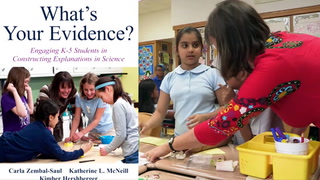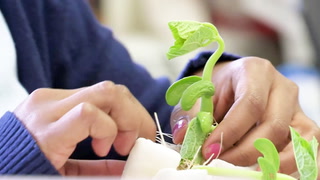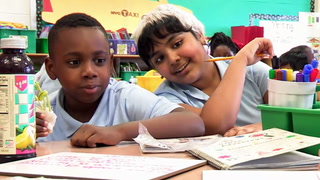Claims, Evidence, & Reasoning: Planning Transcript
K. Hershberger: How do you know they need water? What's your evidence?
Maria: Kimber Hershberger is one of the authors of What's Your Evidence. I could not believe that she was actually gonna come here. She was also a third grade teacher, so I felt this deep connection with her.
K. Hershberger: Did everybody the same one?
Student: Yeah.
Maria: It was really great to have her as a resource.
K. Hershberger: But you're talking about sunlight.
[00:00:30]
[00:01:00] I'm Kimber Hershberger. For the last two days, I've been here working with Maria as a professional development coach, helping her to plan her clues lessons and develop the notion of doing CER with her students. Teachers will know that there's a classic KWL chart, which uses what do kids know, what are they wondering and what have they learned, but we decided to revamp that for science, and especially add a column on evidence. And then have added the S part for science knowledge and science words.
Maria:
[00:01:30] The clues chart is a great tool to really make all the teachers step back and think about what they're doing and how it's effective for their teaching and the student's learning. If we use this tool, you can see where things should be, what should be taught, and how it will turn into student led discussions and investigations and observations. And I think that it'll really be great.
K. Hershberger: Can you explain to us the investigation that you set up to help them understand the germination process?
Maria:
[00:02:00] Yes. What we decided to do was see if a bean can germinate inside of a plastic baggie. We wanted to see what it needs to germinate. I gave the kids the choice, you put it where you want it to be, so some that had prior knowledge for what they thought they knew were like, "I want mine to be in sunlight. I want it to go on the window." So I taped theirs onto the window. Some wanted to be in the closet, just because I think they were curious, like will it grow, so they put it in the closet. The other choice was how much water they wanted to put. We put 30 milliliters of water. If some people did not want that, they left theirs dry. And then others just spritzed it a little bit and again, closed the baggie and that was it. On the days that we checked, they would see if anything happened to their bean that looked like significant growth.
[00:02:30]
K. Hershberger:
We talk about claim evidence reasoning when we're doing this process, and we always need a question to focus on. And so we begin talking about what is your question.
Maria: The lesson was going to be focused on a question, "What do kidney beans need to successful germinate?"
K. Hershberger:
[00:03:00] She initially had a longer question, and as we talked more and more, we realized that the question needed to be simplified, so that the students could make claims that really were connected to germination.
Maria: We decided that instead of it being that full question, what do kidney beans need to successfully germinate and thrive, we're cutting it to just germinate today.
K. Hershberger: As you're thinking about that, cutting down that question, do you think that will be helpful to the students?
Maria: After our discussions yesterday, I could tell that this is a harder concept than I think it is. If they're not getting what it needs to germinate, they can't possibly successfully know what it needs to thrive.
[00:03:30]
K. Hershberger:
And also, you're trying to work with them on the CER process. You're trying to get them ... This is really the first time they've used that world, claim, and then linked it to evidence. If you have something that's more clear, like just talking about the germination, I think it will help that process.
Maria: I agree.
What is our focus question for today?
Student: What do kidney beans need to successfully germinate?
K. Hershberger:
[00:04:00] I think it's important to talk with a person about how do they visualize the lesson. What do they see happening?
Maria: The first task is I want them to give me a student definition for the word germinate. From all the learning that they've done, what do they think the word means.
K. Hershberger: Yeah, so you're creating a class definition.
Maria: Yes, class definition.
K. Hershberger: It's really their ... What definition does the class and how are you going to do that?
Maria:
[00:04:30] I'll be putting them in groups and within each group, they're gonna have a whiteboard, and they will write the word germinate and come up with what they think is the best possible definition.
K. Hershberger: Sometimes when people do science lessons, they start by just having kids write down the definitions, but this is really different.
Maria: It is different.
K. Hershberger: Because your students have a lot of background about germinating.
Maria: Yes.
K. Hershberger: They've seen it and now they're ready to make a definition.
Maria: Hopefully.
What do you think germination is?
Student: It means to grow or sprout.
Maria: Or sprout, okay. Do you guys agree?
Student 2: Yeah. Yes.
K. Hershberger:
[00:05:00] To me, a really important part of planning for clues in CER is to really think through what claims can the students make based on the investigations, and then what evidence do they have. What specific evidence will they have to support that?
Maria: Then we're gonna talk a little bit about claims.
K. Hershberger: And just very simply-
Maria: Very simply.
K. Hershberger: Claims do what?
Maria: Claims is answering the question, so our focus question is what do kidney beans need to successfully germinate.
[00:05:30]
K. Hershberger:
And answering that based on what you've done.
Maria: Our investigations, our observations. And I'm gonna talk a little bit about, well what did we do, so that you know the answer to that question. What did you see? What have we been talking about?
K. Hershberger: What are you thinking about the claim that they might come up with?
Maria: I'm thinking that they will say that the bean needs nutrients and water, but what we discussed yesterday made me think that they will possibly say the things that they already know it does not need to germinate, so then we'll be able to have those-
K. Hershberger: For instance-
[00:06:00]
Maria:
Like sunlight or soil, though we put them in baggies and they know that they don't have soil, and almost all of them germinated with just the water. But that's good because then they can prove themselves wrong.
K. Hershberger: They can use their evidence-
Maria: Right.
K. Hershberger: To clarify and in their small groups, other students can respond.
Maria:
[00:06:30] There are some students that will be at a table with someone whose bean was on the window, or whose bean was in the closet. So it'll be cool to see the difference in what their evidence is if they're all trying to get to the same claim.
K. Hershberger: And then we'll push questions like, what's your evidence.
Maria: Right.
K. Hershberger: How do you know that? And then do you agree, do you disagree.
Maria: I hoping that with the student to student agreeing and disagreeing that it will just come out naturally for them without us really prompting. But if necessary, we could-
K. Hershberger: It's fine to prompt them.
Maria: Like, "What do you think about the light?"
K. Hershberger:
[00:07:00] And that's part of our role, I think, to help them clarify. Like, "Do you agree with what this student said? Why? Why not?"
Maria: So that's exciting.
K. Hershberger: Yeah. I think it will be good to have a discussion about the poster, in terms of how we want them to do that. Okay. They're going to write the question, which is about germinate.
Maria: Yes.
K. Hershberger: What does it take for the kidney bean to germinate? And then write claim, and then write some claims to answer that question. They could have another sheet to write the evidence, you know.
Maria: Yeah, absolutely. I think that would work. And then it'll be like their own little clues chart because they were so excited when I put it up.
[00:07:30] I think it's more meaningful to you guys and to me if you come up with a definition and then we put it in our science words and concepts together.
In the beginning of this whole, the clues chart, I was a little hesitant. I was excited, but I was also like, "Can I do it justice?"
K. Hershberger: It's a tool that can be used and it's used as a visual to help students put things together, but make it yours.
Maria: I'm hoping that everything that we're planning right now really goes the way it's supposed to. And even if it doesn't, I know.
[00:08:00]
K. Hershberger:
I think that I'm gonna push back on that, the way it's supposed to.
Maria: Right. Well, science is-
K. Hershberger: Yeah. And what's really, we're listening for is what the students are saying. It was not a certain way.
Maria: Exactly.
K. Hershberger: You know. It need to work for you and the lesson that you're doing, and that's what we're trying to do, is make it fit.
How did we do?
If you rate this transcript 3 or below, this agent will not work on your future orders














4 Comments
Christine Garner Feb 17, 2021 12:01pm
1. The KLEWS strategy adds Evidence and Science concepts to the traditional KWL-Know-Wonder-Learn strategy. The broader concept of CER, is Claims, Evidence and Reasoning is ideal for deeper learning and investigation of science concepts.
2. Ms. K revised her focus question or claim to be more specific. Her initial question was asking about two different concepts.
3. They discussed ways to guide questioning that would help the students get the most out of the lesson.
Maria Katsanos Nov 29, 2018 5:00pm
Hi Theresa! That’s me in the video, I’d love to hear how it went with your class!
Theresa Baricovich Oct 2, 2018 6:47am
I am excited to use the KLEWS strategy in my 3rd grade classroom tomorrow! I also will try to limit my focus questions to one idea at a time. Thanks for the insight! Terri B Willow Springs School, Willow Springs, Il.
Maria Katsanos Nov 29, 2018 5:01pm
Hi Theresa! That’s me in the video, I’d love to hear how it went with your class!